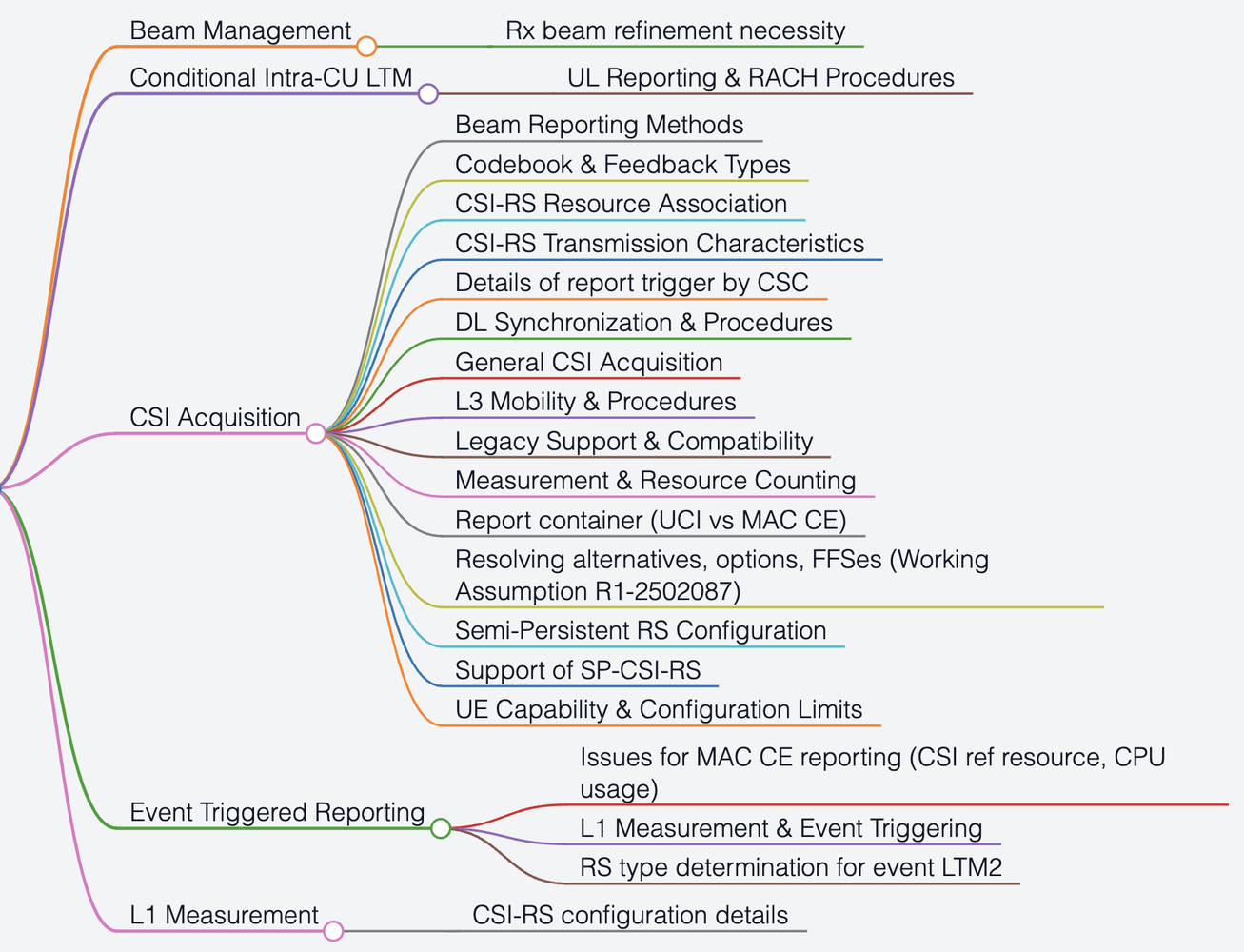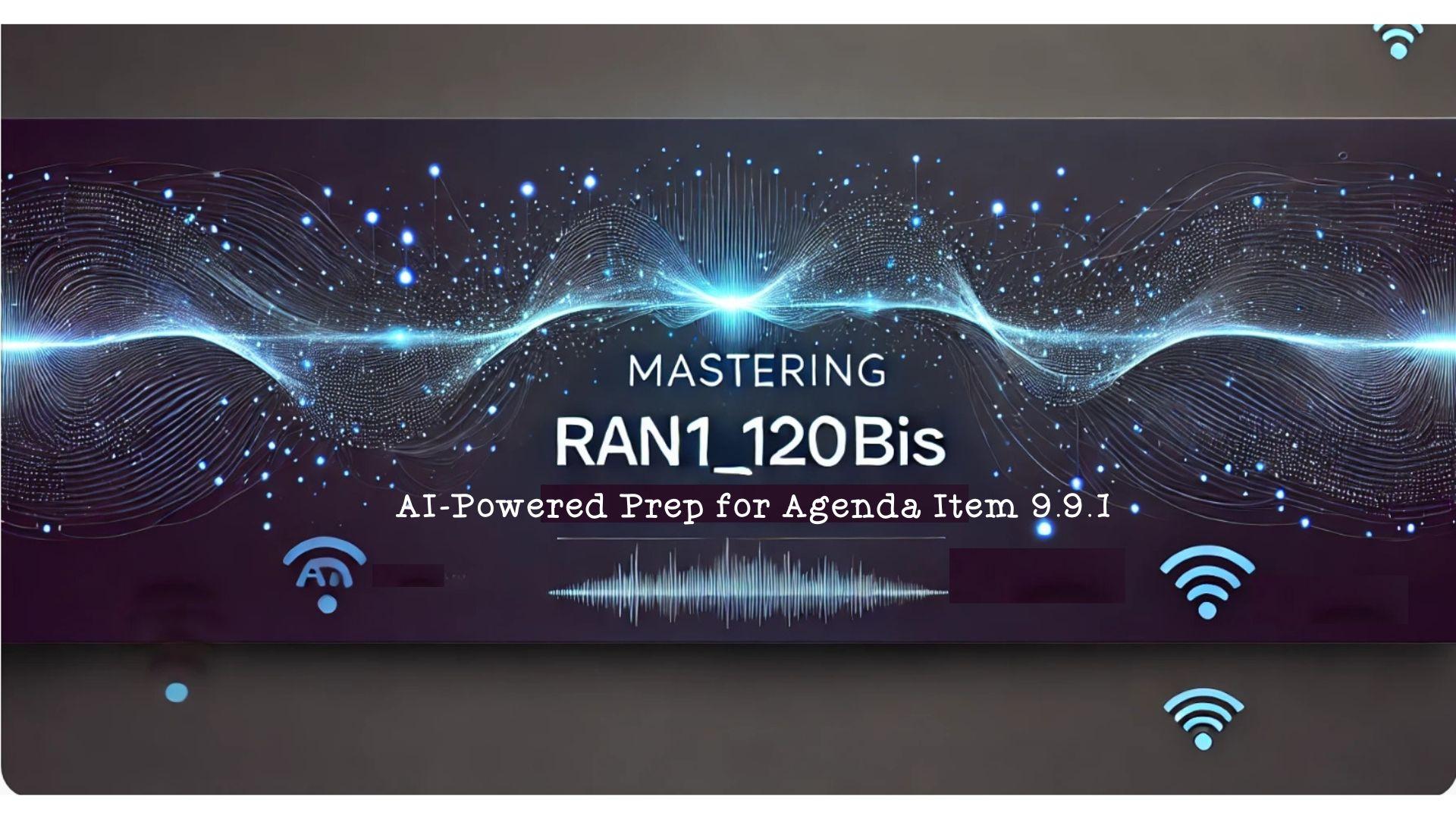Executive Summary
For 3GPP RAN1 delegates, RAN1_120bis presents a defining opportunity to shape Release 19. For instance, in agenda item 9.9.1: Measurements-related enhancements for LTM, 26 TDocs comprising 307 proposals are packed with critical insights—if you can extract them.
Manual .docx reviews are inefficient. Data-driven analysis and AI-enhanced structuring unlock a strategic edge.
This article explains why these insights matter, exposes the limits of conventional prep, and demonstrates how AI can elevate your influence and efficiency going into RAN1_120bis.
Meaningful and Useful Data Insights for RAN1 Delegates
The structured analysis of RAN1_120b’s 26 TDocs reveals several key patterns for agenda item 9.9.1:
Whole picture of technical issues
According to R1-2502087, the feature lead organizes technical issues and corresponding priorities to be discussed in RAN1_120b. In addition, 307 proposals further reveal several different technical focuses from various sources’ perspectives. As shown below, the proposals are distributed in 5 major categories and 21 sub-categories.

Technical issues identified from the proposals based on R1-2502087

Landscaping for proposals distribution over Lv1 technical issues of RAN1_120b’s agenda item 9.9.1
CSI Acquisition: Dominant and Diverse
Over 80% of proposals focus on CSI acquisition, a key measurement aspect for LTM. Examples:

Part of proposals distribution over Lv2 technical issues of RAN1_120b’s agenda item 9.9.1
- Huawei (R1-2502214) submitted 21 proposals, including Proposal 7 on activating SP CSI-RS before CSC.
- LG Electronics (R1-2501756) backs UCI-based reporting (Proposal 11) and multiple configuration options (Proposal 9).
- Ericsson (R1-2502562) supports MAC CE reporting (21 proposals total, including Proposal 14).
- Qualcomm (R1-2502853) and Nokia (R1-2502653) align on Type I codebooks.
Event-Triggered Reporting: Prioritized for Impact
7% of proposals (23 of 307) are marked “High Priority,” many addressing LTM2 RS types.
Examples:
- CATT (R1-2502006) proposes RRC-configured RS (Proposal 3 – “High”).
- MediaTek (R1-2502929) supports the same in Proposal 1 (“Mid” priority, but strategically relevant).
Key Contributors and Strategic Positioning
- Nokia (R1-2502653, 27 proposals): covers both CSI and LTM—UCI reporting (Proposal 9) and RS for LTM2 (Proposal 25).
- Huawei and Ericsson: each submitted 21 CSI-heavy proposals.
- Sharp (R1-2502490): submitted 7 niche proposals, including Alt 2 + Alt X (Proposal 1).
Priority Mix: Focus Where It Matters
- 7% High Priority (23 proposals): Core FFS and architecture discussions
- 89% Mid Priority (272 proposals): Technical refinements
- 3% Low Priority (9 proposals): Peripheral items
- 1% Other (3 proposals): Mixed/undecided (e.g., “Mid/Low”, “Needs Discussion”)
Pain Points of Conventional TDoc Review
Cracking 26 TDocs without insights is a slog. Open R1-2501756 to R1-2502929, sift through 307 proposals in .docx files, and manually hunt for trends—conventional manual review is slow and risky:
- Time-consuming: Hours spent opening and reading .docx files cuts into technical preparation.
- Trend-blind: Important dynamics like UCI vs. MAC CE can be missed without structured comparison.
- Risky: Missing a Nokia FFS proposal or underestimating Huawei’s SP CSI-RS initiative could weaken your position during live debate.
The old way doesn’t scale for Release 19.
AI Solution: Structuring Your Strategic Advantage
AI turns proposal overload into a strategic asset:
- Fast Mapping: All 26 TDocs parsed into structured CSVs with TDoc ID, source, proposal content, category, and FL priority.
- Trend Clarity: Algorithms surface dominant themes (e.g., CSI), company positions, and hot zones.
- Targeted Filters: Sort/Filter interested proposals by priority, company, or category in seconds.
- Visual Edge: Dashboards and charts reveal the thematic shape of agenda item 9.9.1 instantly.
This reflects the capabilities of platforms like ixi.wispro.com—designed for real-time 3GPP TDoc analytics.
Gear Up for RAN1_120bis
RAN1_120bis is your moment to shape agenda item 9.9.1—Measurements related enhancements for LTM—and 26 TDocs from RAN1_120b prove data trumps drudgery. AI makes it happen. Don’t slog through .docx files when you can lead with insight.
- Advocate: Push your team for AI tools to nail 9.9.1 prep—turn insights into influence.
- Engage: Comment below—how do you prep now, and could AI change it?
From Huawei’s CSI push to Nokia’s LTM edge, you’ve got influence to wield. RAN1_120bis is where clarity, preparation, and insight will make the difference. Don’t follow the file trail—lead the conversation. Who’s ready to step up?
If you’re interested in trying our interactive dashboards to review the proposals above, checking the AI-mapped proposals in CSV file, or have ideas for new features to help 3GPP delegates and feature leads, let’s connect—comment below or message me directly.
The original article is from https://www.linkedin.com/pulse/mastering-ran1120bis-ai-powered-prep-agenda-item-991-lin--vlnoc/?trackingId=PuzWKHSMQ3aXJ3%2FG4TbkeA%3D%3D

